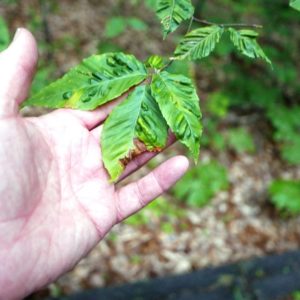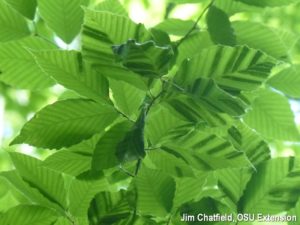By Elly Voigt, forest health lab assistant, Fitchburg
Beech leaf disease (BLD) is a relatively recently discovered, destructive disease of beech trees in the US. It was first observed in 2012 in Ohio and has since spread to areas of Pennsylvania, New York, Connecticut, Rhode Island, Massachusetts and Ontario, Canada. BLD affects our native beech species, American beech (Fagus grandifolia) and ornamental beech species, including European beech (Fagus sylvatica). The disease has not yet been observed in Wisconsin but could become an issue in the future.

Symptomatic leaf puckering of a beech tree with BLD. Credit: Ohio State University.
Symptoms of the disease include dark striping or banding between the leaf veins. This symptom is best observed by standing below the tree and looking up at the bottoms of the leaves. Diseased leaves may also pucker, curl, become thick and leathery in texture, or develop yellow or necrotic (dead) areas. On a BLD-infected beech tree, you may see buds that never leaf out, dead twigs and branches, or a loss of leaves throughout the tree. Over several years, BLD can kill entire beech trees, especially smaller, young trees.

Symptomatic banding on beech foliage, as well as asymptomatic leaves. Credit: Ohio State University Extension.
The cause of BLD is not yet fully understood, and research is ongoing. Recent research out of Holden Forests and Gardens in Ohio, the USDA, and partners in Ontario revealed an association between BLD symptoms and the presence of a species of nematode (microscopic roundworm) in the buds of beech trees. Crude extracts of these nematodes have been inoculated onto seedlings and have produced symptoms similar to those of BLD. However, this nematode (Litylenchus crenatae) has not been confirmed as the sole cause of BLD.
Beech trees are important in our forests for many reasons, including providing food for wildlife. If you see symptoms of beech leaf disease in Wisconsin, please contact your regional forest health specialist.
